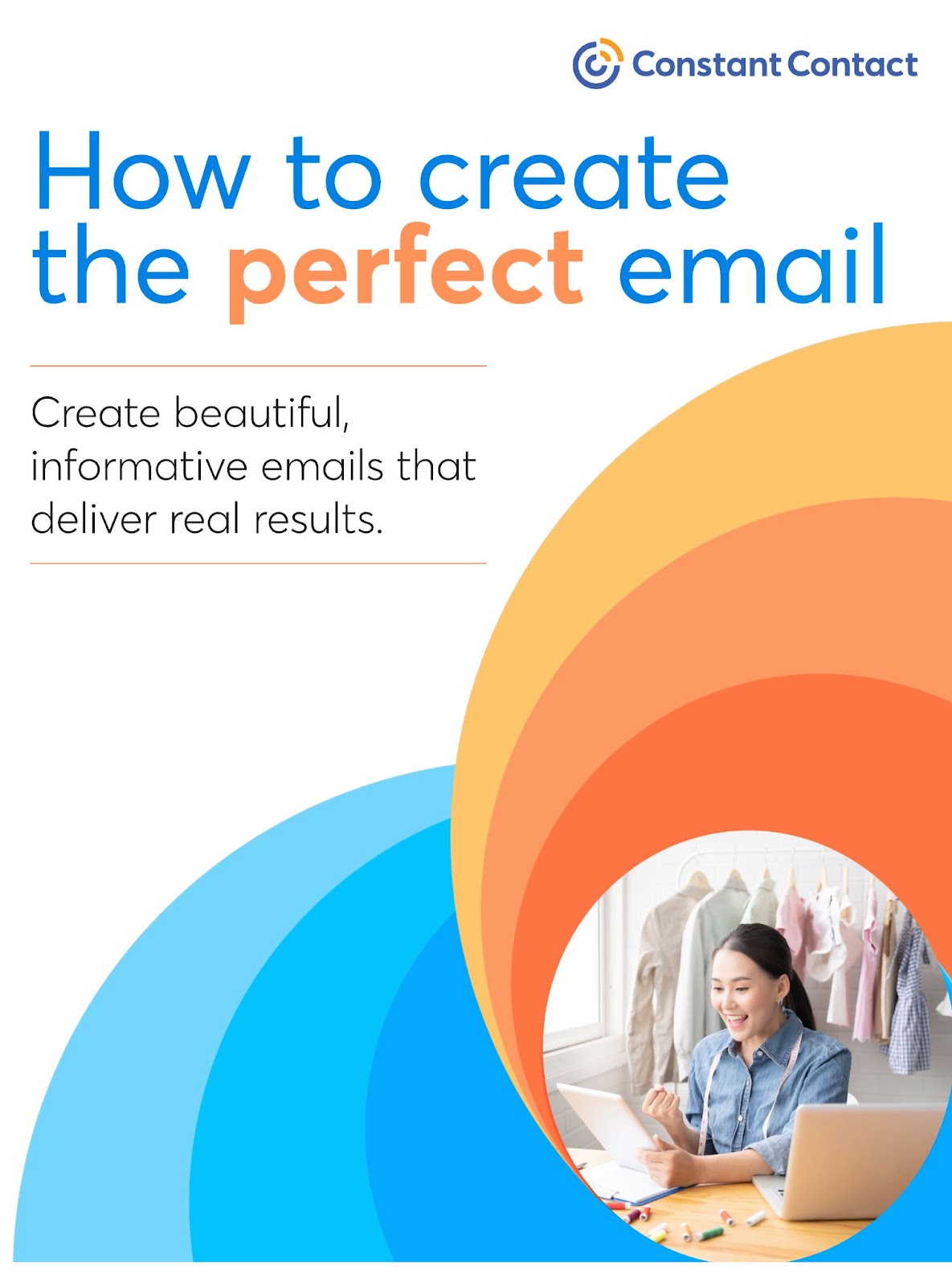
You’ve spent weeks, months — maybe even years — crafting the perfect new product for your customers. You’re ready to start selling, but you need to make your customers aware of what your product offers and how it will benefit them.
While there are many ways to introduce your new product, product launch emails rank among the best options. A well-designed product launch email showcases your product and its features, building buzz with your audience. And, since your subscriber list is already familiar with your company, they’re more likely to pay attention.
With a solid product launch email campaign, you can capture your customers’ attention and generate early interest in your product.
Essential components for crafting product launch emails
Some of the best product launch emails include these elements.
Effective subject line
The subject line is arguably the most crucial part of your product launch email. Irresistible product launch email subject lines attract reader interest, encouraging them to open your message. If your subject line isn’t appealing, the recipient may ignore your email and miss out on your exciting news.
A compelling email template
Your email template forms the basis of your message structure. Look for a template that’s easy to follow and organizes your message content.
Persuasive email copy
Aim for messaging that explains how your product benefits your customers. If your readers understand its value, they’re more likely to take action.
Engaging visuals
Pictures, video demonstrations, and other graphics capture your reader’s attention.
Social proof and testimonials
Client testimonials and other social proof add credibility to your product launch email.
A clear and strong call to action (CTA)
Your call to action (CTA) urges readers to act by ordering your product, learning more about its benefits, booking a demonstration, etc. Use encouraging language, buttons, and links to make it easy for customers to take the next step.
Different types of product launch emails
There are several forms of product launch emails to choose from.
Teaser email
Think of a teaser email as your pre-launch email. It’s usually sent a few days or weeks before a product becomes available, creating anticipation with your pre-launch email list audience. A teaser email might include a compelling product image or messaging encouraging readers to stay tuned for what’s coming.
Announcement
Announcement emails share your big news: a new product launch! You can use an announcement email to explain the specifics of your product, like what it is and when it will be available.
Early access invitations
Do you have a few notable clients you want to reward for their loyalty? Give them an exclusive, early access invite to try your new product.
Launch day emails
Use a launch day email to notify subscribers of your product’s availability on launch day. You might include a special promotion or discount to encourage purchases.
Follow-up and thank-you emails
As your subscribers learn more about your new product, you’ll likely see an uptick in your website traffic and customer interactions. Keep your customers engaged with follow-up emails designed to pique their interest. And if they buy your new product, remember to thank them.
Best practices for product launch emails
Consider these best practices to get the most out of your next product launch campaign.
1. Segment your audience
You probably know a lot about your customer base — their demographics, location, interests, and prior shopping history. Use the information to segment your audience into different groups. You can tailor your product launch emails to fit each segment.
2. Personalize your message
Make the most of your segmentation process, and give your product launch emails a personal touch. Adding the recipient’s name or providing the nearest location of your store tells your audience you pay attention to each customer.
3. Time your email sequence
Decide the best time to send and sequence your emails for your product launch campaign. You might start with teaser emails a few weeks in advance, then move onto early access invites in the days before wide release. You can automate follow-up and thank-you emails based on customer interactions. Some marketers utilize drip campaigns to build client interest.
4. Test and optimize emails
Consider sending a few test emails to a portion of your subscriber list to evaluate performance. Switch up certain elements — like subject lines, messaging copy, and graphics — to see which emails perform best. You can use the results to optimize your messaging.
5. Ensure mobile-friendly designs
Many of your subscribers will read your email on their smartphone or tablet. Choose a responsive email template that displays well on mobile devices, PCs, and laptops.
6. Maintain brand consistency
You don’t want to confuse your customers, so make sure your product launch email matches your brand’s identifying aspects. Use your company’s traditional color scheme, include your logo, and maintain the same messaging tone in your email.
Planning a product launch email sequence
As you plan your campaign, consider your email sequence strategy. Several emails, rather than just one, will help you generate interest, maintain momentum, and keep customers engaged once your product launches.
- Map your sequence timeline: Use an outline to map out your email sequence. Set timeframes for each email. For instance, you might send teaser emails a week or two before the product launch, an announcement several days beforehand, and follow-ups after the big day.
- Coordinate with product availability: Companies sometimes minimize production of a new product until they know how much demand it will generate. Consider your available inventory as you initiate your product launch. If clients can’t order your product because it’s unavailable, it can damage your brand reputation.
- Offer exclusive deals or incentives: A one-time discount or other incentive can encourage clients to take action and buy your product. If they like it, they’ll share their experience with others, helping you broaden your customer base and increase product revenues.
Real-world product launch email examples
What does a successful product launch campaign look like in practice? Let’s look at some real-world product launch email samples.
AllTrails: New collaborative lists
AllTrails recently used a product launch email to showcase new collaboration features. The email includes several vital elements to product launch campaigns, including a how-to guide, a responsive template, and a clear CTA.
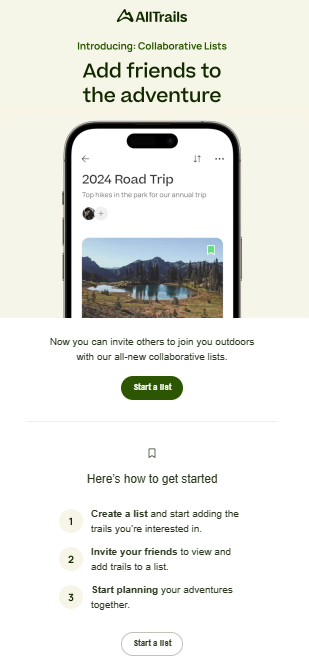
Oakley: New lenses
Oakley‘s product launch email combines stunning graphics and persuasive copy to encourage readers to buy its sunglasses. It indicates the glasses are limited edition, so readers must take quick action to secure their pair.
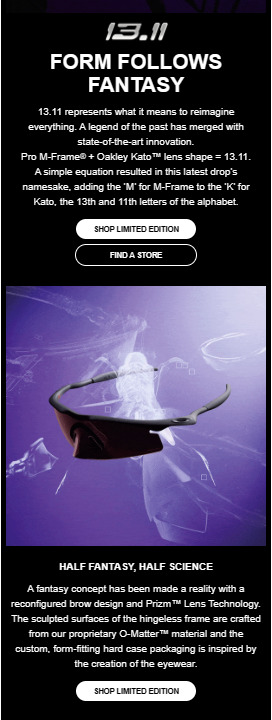
Apple: Vision Pro
Apple‘s email introduces its newest product — the Vision Pro — using its familiar brand logo and color scheme. It encourages readers to take action by pre-ordering online or scheduling a demo at their local Apple store.
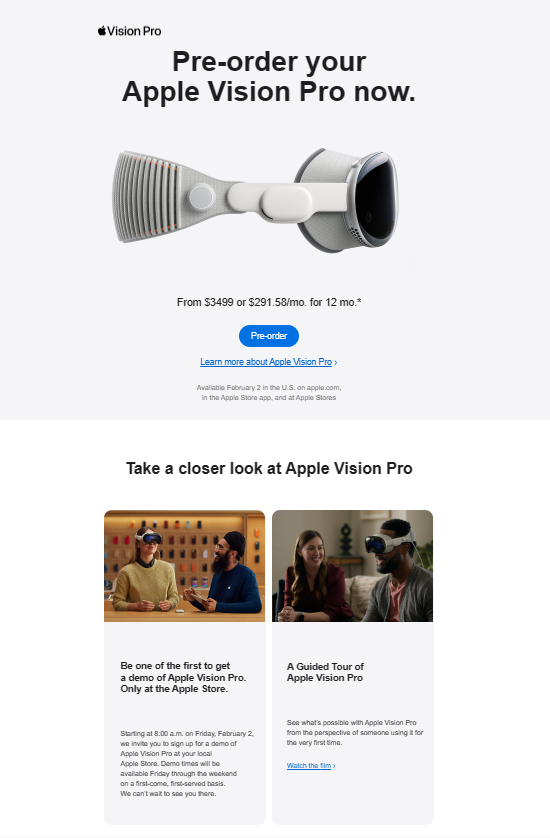
Lucky Brand: Introducing new jeans styles
Lucky Brand‘s product launch email showcases new jeans styles for the season. It includes a special 30% discount and CTAs to encourage subscribers to browse the options and buy.
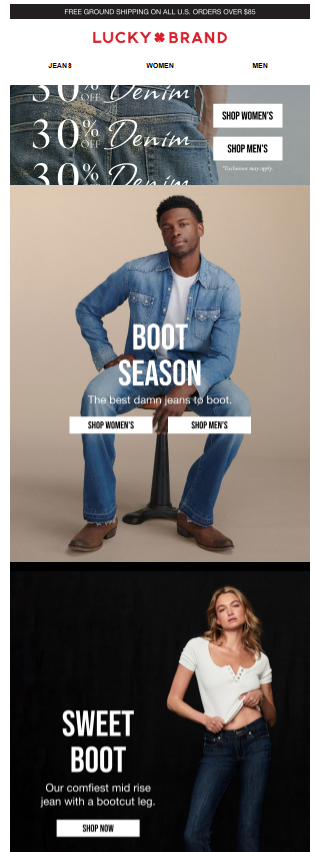
Gathering inspiration for different industries
Whether introducing a new service, a product for other businesses, or retail items, you can benefit from an email marketing strategy that connects with clients. Keep the crucial elements of a product launch email in mind — your subject line, messaging, template design, and CTA.
Technical aspects and considerations
There are a few technical aspects to remember in your product launch strategy.
Ensuring deliverability and avoiding spam filters
If you encounter deliverability issues, investigate the source. Hard bounces usually indicate an invalid or closed account, so you’ll want to remove the address from your subscriber list to maintain its integrity. A soft bounce might suggest the recipient’s email service provider is down, so you can try again later.
Email service providers may kick your message to spam if subscribers regularly complain about your emails or if you use spammy language in your content. Keep your message direct and provide value to clients to ensure email deliverability.
Setting up automation tools
Automation tools help you optimize your campaigns and schedule your campaign sequence. With Constant Contact’s email marketing software, you can manage your subscriber list in one place, automate your emails, access product launch templates, and customize your message to fit your brand.
Tracking and analyzing email performance metrics
As you implement your product launch campaign, pay attention to your metrics. Your open rate, click-through rate, and conversions all help you understand whether your campaign is delivering the desired results. You can create email marketing benchmarks to review results as you build your analytic database.
Integrating with other marketing channels
Integrating your email marketing strategy with other channels — like social media, internet ads, and print ads — lets you develop a comprehensive, holistic advertising strategy for your customer base. Constant Contact’s software includes a full suite of integrations, including Facebook, Instagram, Salesforce, WordPress, Canva, and many others.
Challenges and issues in product launch emails
Occasionally, marketers encounter hurdles with their product launch email campaigns. Here are a few to look out for and how to handle them:
- Handling negative feedback: Not every new product will meet your customers’ expectations, and that’s okay. If you receive complaints or requests to unsubscribe from your email list, address them courteously and take appropriate action.
- Managing expectations: Marketers sometimes set their expectations too high and then get frustrated when they don’t see results. If you don’t receive the customer response you’re hoping for, look at your campaign strategy to see where you might improve.
- Overdelivering value: Many successful brands use simple messaging to introduce new products. There’s no need to overexert yourself on a product launch email — instead, include a link that provides more in-depth information on a dedicated landing page or blog post.
Post-launch strategies
Your marketing work doesn’t end once your product launches. Instead, use these strategies to keep the interest going and encourage purchases.
Maintaining momentum after the launch
Send subscribers a follow-up a few days after your product launches — or even the next day. Include unique messaging highlighting your product’s features and why it adds value to the customer. You can send a few more follow-ups over the next few weeks; just make sure to vary your messages so it’s not spammy.
Post-launch nurturing
It may take some customers longer to decide whether or not to buy your new product. Keep pushing them through your buying funnel with various engaging incentives, like product demonstrations, how-to guides, or discounts.
Scaling up the campaign
If your product takes off in a big way, scale your product launch campaign into your regular marketing practices. Introduce it to your social media followers and consider other channels, like internet ads or commercials.
Advanced strategies and campaign enhancements
Once you’ve mastered the art of the product launch email, you can try a few advanced techniques.
- Cross-promotions and partnerships: Consider partnering with a complementary brand to promote your product and theirs via email or other marketing channels.
- Influencers and brand ambassadors: Connecting with an influencer whose audience mirrors your customer base can drum up serious interest in your product.
- Interactive and experiential email elements: With today’s technical advancements, you can include innovative email features like 3D tours. Some brands include functionality that lets customers “try on” new clothing or accessories virtually.
Common questions on product launch emails
How often should I send product launch emails?
More than once! Many brands send multiple product launch emails and establish a sequence timeline that spaces out their delivery.
Are there any legal requirements I need to be aware of?
Yes. There are numerous laws and regulations concerning email marketing. It’s imperative to speak with a qualified attorney before beginning an email marketing campaign so you understand your responsibilities.
How can I continuously improve my skills as an email marketer?
Stay on top of marketing trends through Constant Contact’s extensive blog. Of course, the more often you practice your skills, the more progress you’ll see!
A successful product launch campaign starts with a game plan
Developing an exciting new product is something to be proud of — but the real rewards come from successfully marketing it. When people know about your product and understand its value, they’re more likely to buy; that’s when you’ll see the money come in.
Start your next product launch email campaign by mapping out your sequence strategy, then move on to designing your emails. Download the guide below to learn how to create the perfect email with all the essential components for best results. As you build your skills, try out some advanced techniques, too.
